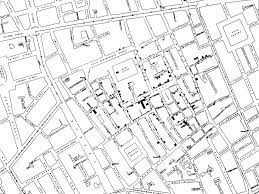Posted on September 8, 2021
This is an update of my post published on September 8, 2010:
There once was a television show called NUMB3RS about a mathematician who used his math to help the FBI solve cases. To me, the history of the 1854 cholera epidemic in London reads a bit like a NUMB3RS episode!
Most people back in the mid-1800s thought that illness was caused by breathing “bad air” or miasma—breathing poisonous vapors of some sort.
We know - especially now, living through the COVID-19 pandemic - that some illnesses are in fact connected to the air we breathe. But we now know that it is airborne germs (viruses, bacteria, fungi, etc.) - not "poisonous vapors" - that cause those diseases. In the mid-1800s, the germ theory wasn't yet established.
Also, some illnesses aren't transmitted through air.
When there was a deadly outbreak of cholera in London, Dr. John Snow talked to residents and created a map showing the location of the cases. With the map, he realized that the miasma theory of the cause of the disease didn't match the evidence. Using the interviews and the map, Dr. Snow was able to trace the outbreak to the public water pump on Broad Street in Soho.
Snow was most convinced that the pump was to blame when he discovered that people who lived nearby who did NOT use water from that pump also did not come down with cholera.
Snow examined a sample of the water through a microscope, and ran some chemical tests as well, and he was not able to conclusively prove its danger. However, he still used statistics and his map to convince the local council to disable the water pump by removing its handle on this date in 1854.
And the outbreak stopped.
Later, it was discovered that this public well had been dug only three feet from an old cesspit, and it was being polluted by sewage.
Dr. Snow went on to use statistics to show that a waterworks company was using water from sewage-polluted portions of the Thames River for use in homes—and those homes suffered from more cases of cholera than other homes. Because of Dr. Snow's work, our understanding of disease prevention and public health took a giant leap.
Hooray for numbers!
Learn more...
- Here is a virtual tour of a modern water treatment plant. And here is a longer (and I believe better) video tour.
- Part of numbers and statistics is probability. Try using this dice-roll simulation. Roll the dice 5 time, then 50, 500, and 5000. How does the number of rolls affect the results?



















No comments:
Post a Comment